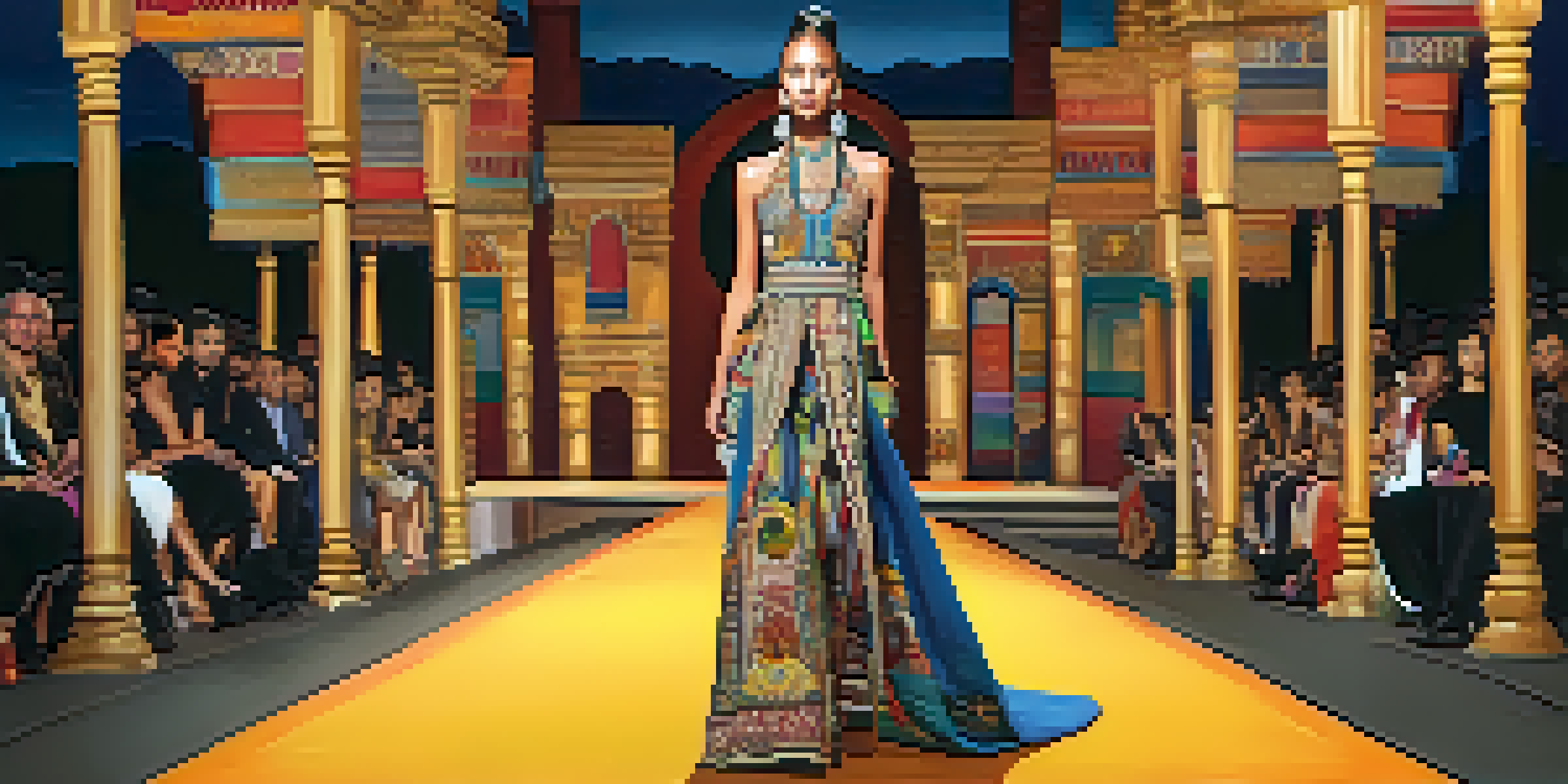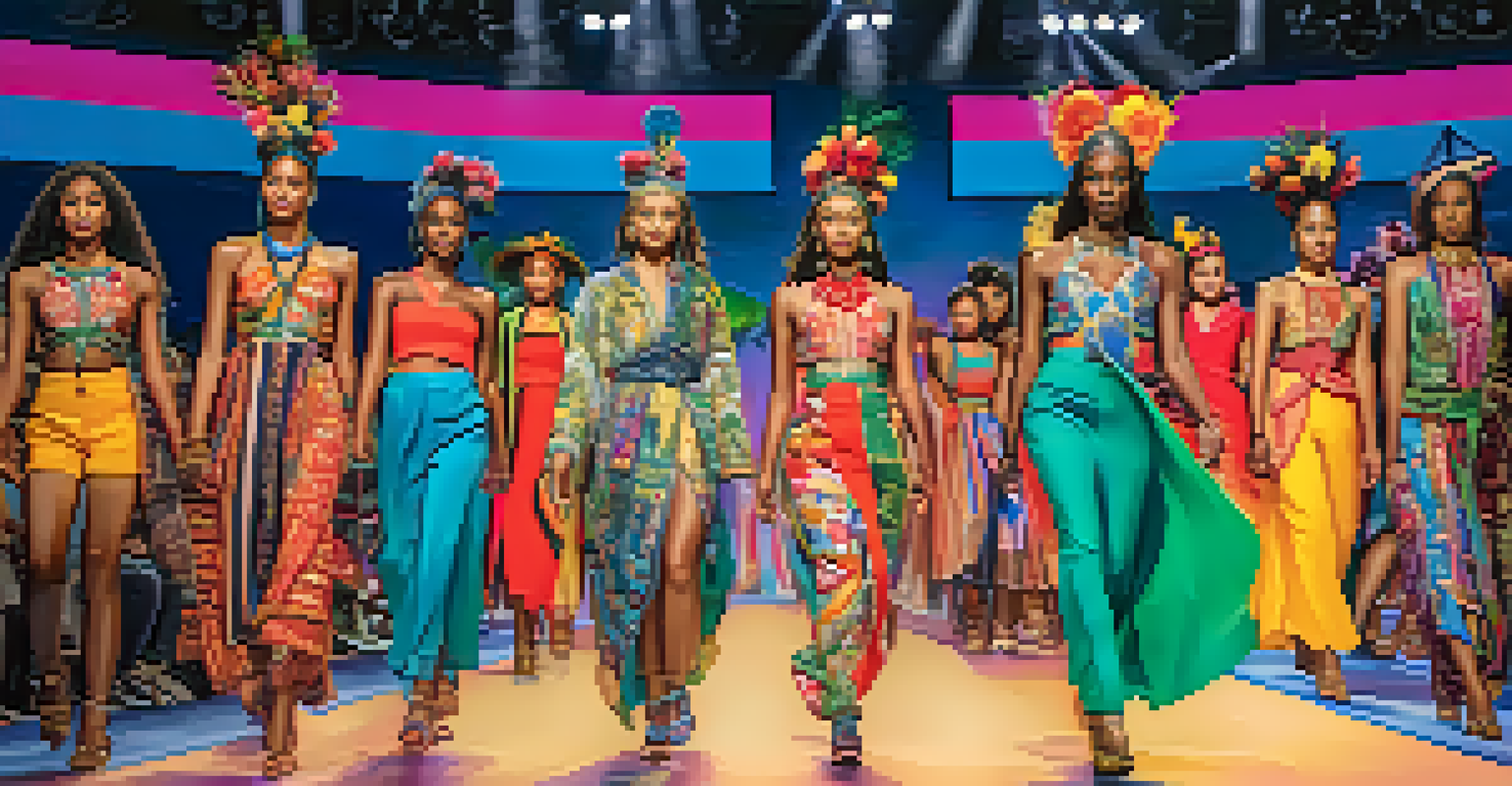Cultural Influences in Luxury Fashion Show Design

Understanding the Role of Culture in Fashion Design
Culture plays a pivotal role in shaping the aesthetics and themes of luxury fashion shows. Designers often draw inspiration from their heritage, personal experiences, and societal trends. For instance, the use of traditional textiles or motifs can create a deep connection between the audience and the designer's story.
Fashion is the armor to survive the reality of everyday life.
Moreover, cultural influences can extend beyond fabrics and colors, impacting the overall atmosphere of a show. Think of a runway adorned with elements from a specific culture — it invites viewers to experience a unique visual narrative. This connection can evoke emotions and spark conversations among attendees, making the show memorable.
As globalization continues to blend various cultural elements, luxury fashion shows often showcase a melange of influences. This fusion not only celebrates diversity but also invites designers to push the boundaries of creativity, leading to innovative designs that resonate with a broader audience.
Historical Context: How Past Cultures Influence Today’s Trends
Looking back, many luxury fashion houses have tapped into historical influences to craft their collections. For instance, the Victorian era's opulence often reappears in modern designs, characterized by intricate lace and bold silhouettes. This homage to history enables designers to create pieces that feel both timeless and contemporary.

Furthermore, significant historical events can shape fashion narratives. The resurgence of 80s and 90s styles in recent years highlights how nostalgia plays a role in current trends. Designers often reinterpret past styles, breathing new life into them while keeping cultural significance intact.
Culture Shapes Fashion Aesthetics
Designers draw inspiration from their cultural heritage and societal trends, creating collections that tell unique stories.
In this way, the cycle of influence between cultures and fashion is ongoing. Designers can reference historical elements while also addressing modern aesthetics, creating a dialogue between the past and present that enriches the luxury fashion experience.
The Impact of Globalization on Fashion Show Design
Globalization has transformed the landscape of luxury fashion show design, allowing for an unprecedented exchange of cultural ideas. Designers are no longer confined to local influences; they can incorporate global trends and aesthetics into their work. This cross-pollination leads to a more vibrant and diverse fashion narrative.
Style is a way to say who you are without having to speak.
As a result, fashion shows often reflect a blend of cultural elements, showcasing everything from African prints to Asian silhouettes. This diversity not only appeals to a wider audience but also fosters appreciation for different cultures. A single show can serve as a microcosm of the world, where various influences converge.
However, it's essential for designers to approach this blending respectfully. Authentic representation ensures that cultural elements are celebrated rather than appropriated. This mindful approach enriches fashion shows, creating a deeper understanding of the cultures being represented.
The Role of Technology in Cultural Representation
Technology has become a powerful tool in luxury fashion show design, enabling designers to showcase cultural influences in innovative ways. For instance, virtual reality can transport audiences to different cultural settings, enhancing their understanding of the inspirations behind a collection. This immersive experience adds depth to the fashion narrative.
Additionally, social media has allowed designers to share their cultural inspirations on a global scale. Platforms like Instagram or TikTok enable them to engage with audiences, providing insights into the creative process and the cultural significance behind their designs. This transparency fosters a more authentic connection between designers and their audiences.
Globalization Fuels Fashion Diversity
The blending of cultural elements in fashion shows promotes a vibrant narrative that resonates with a broader audience.
Moreover, technology facilitates collaboration between artists from diverse backgrounds, leading to unique fashion interpretations. These collaborations often result in shows that celebrate cultural diversity, making them not just a display of fashion but also a celebration of humanity.
Sustainability and Cultural Considerations in Fashion Shows
As the fashion industry increasingly prioritizes sustainability, cultural influences also play a crucial role in shaping eco-conscious designs. Many cultures have long traditions of sustainable practices, such as using natural dyes or upcycling materials. Designers who honor these traditions can create collections that are both stylish and environmentally responsible.
Moreover, showcasing sustainable practices during fashion shows can amplify their cultural significance. For instance, a collection that highlights indigenous craftsmanship not only promotes sustainability but also honors the artisans' cultural heritage. This approach resonates with audiences who are becoming more mindful of their purchasing decisions.
Ultimately, integrating sustainability with cultural influences enriches the luxury fashion experience. It encourages a deeper appreciation for the materials and techniques used, fostering a sense of responsibility among consumers to support ethical fashion.
Cultural Storytelling: The Heart of Fashion Shows
At the core of luxury fashion shows lies the art of storytelling, often rooted in cultural narratives. Designers weave tales through their collections, using clothing as a medium to express cultural identity and heritage. Each piece tells a story that invites viewers to explore the designer's vision and the cultural influences behind it.
For instance, a designer might draw inspiration from their travels, integrating elements from various cultures into their collection. This storytelling approach transforms a fashion show into an experience, where the audience is not merely watching but engaging with the narrative. It creates an emotional connection that lingers long after the show ends.
Sustainability Enhances Cultural Design
Integrating sustainable practices with cultural influences enriches fashion collections and fosters ethical consumerism.
Moreover, cultural storytelling can challenge societal norms and provoke thought. By addressing contemporary issues through fashion, designers can inspire conversations around identity, belonging, and cultural appreciation, making their shows not just visual spectacles but meaningful dialogues.
Future Trends: The Evolution of Cultural Influences in Fashion
As we look to the future, the influence of culture on luxury fashion show design will continue to evolve. Emerging designers are increasingly embracing their cultural backgrounds, leading to a rich tapestry of influences that reflect the world's diversity. This trend promises to keep fashion fresh and relevant, celebrating a multitude of voices and perspectives.
Additionally, the growing emphasis on inclusivity in fashion means that more cultures will have a platform to be represented. As fashion shows become more accessible, audiences can expect to see a wider range of cultural narratives showcased on runways. This shift not only enhances representation but also enriches the fashion landscape.

Ultimately, the future of luxury fashion show design lies in collaboration and shared narratives. By honoring diverse cultural influences, designers can create collections that resonate with global audiences, paving the way for a more inclusive and culturally rich fashion industry.